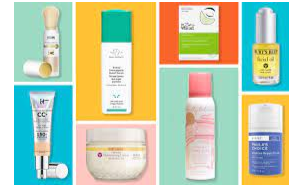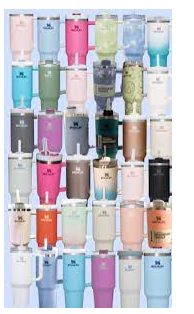Skincare, sugar scrubs, Stanley Cups, oh my! All of these are some of the most trending items on social media and in stores recently. Everywhere from Instagram reels to even the Amazon app itself has advertisements for these trendy items, each promising to be life changing and aesthetic.
Skincare is one industry that is quickly growing. According to Globe Newswire, the market is projected to grow at an annual rate of 8.6% from 2024 to 2034. This trend has been propelled by social media. Skincare routines have become popular among beauty gurus, with many celebrities becoming ambassadors for these brands and even creating their own. These include Kylie Jenner (Kylie Skin), Hailey Beber (rhodeskin) and Harry Styles (Pleasing). Dermatologists and estheticians have also joined these platforms to share their takes. One influential youtuber is Hyram Yarbo, known for his Skincare by Hyram videos on Youtube and TikTok. He rates these celebrity skincare lines, other popular brands and offers additional tips. His product recommendations were so widely followed that in August 2020, he uploaded a video titled “Dupes for Every Sold Out CeraVe and The Ordinary Product”. CeraVe and The Ordinary being brands he has heavily praised in previous videos. This year, Yarbro released his own skincare line, Selfless by Hyram, which is sold at Target and Sephora.

Sephora has been a skincare hotspot as social media has spread skincare to a new audience:the Sephora 10 year olds. This refers to the teenagers and teenagers who purchase trending products from Sephora. The investment banking company, Piper Sandler, recently published a report that found “Teen shoppers spent 33% more on cosmetics and 19% more on skincare this year [2023] than last.” The trend has become controversial because many of these popular beauty products are targeted for older audiences. One example are anti-aging products that contain retinol which is dangerous for young skin. Dermatologist Brooke Jeffy described in USA Today, “When the skin barrier is damaged by constant irritation [from using retinol], like this it gets dry…It’s more prone to infection, more prone to getting rashes, and more prone to breakouts.” The skin barrier is also much more susceptible to pollution and ultraviolet radiation. Many expressed criticism due to viral videos that show sample products being ruined and employees being mistreated by some members of this new group of customers.
Stanley water bottles are another viral trend heavily influenced by social media. One potential cause for this trend is a video from November 2023 that shows a woman sipping out of her Stanley cup that miraculously survived her car catching on fire. This ignited a different kind of spark, and an increase in sales for Stanley products. The brand experienced a jump in annual sales from $75 million to $750 million in 2023, according to CNN. While water bottle trends are nothing new, cue the vsco girls and our hydroflasks from 2019, the way that Stanleys are being sold is. Stanley cups have received endorsements from popular influencers and by having so many different colors and limited editions, have become a collector’s item.

However, it isn’t only skin care items and Stanleys that consumers have been buying. Forbes magazine reported that in 2023, consumers increased their total spending by 5.9%. Shopping still remains a popular activity.
It provides a sense of excitement and anticipation. The hunt for new products triggers the brain’s reward system. It releases dopamine, which gives us feelings of pleasure, satisfaction and motivation. One described that she loves to shop because, “Shopping is an antidote to the work and life-related stressors that I experience. It is a confidence booster and a distractor from daunting tasks..” Retail therapy can be an escape and cheer us up by giving us small thrills to be excited about. Though it can lead to buyers remorse, something that she has often experienced.
She commented, “In some cases..I returned an item or items. Buyer’s remorse has also motivated me to change some habits: waiting at least 24-48 hours prior to making a purchase or asking myself what things I forgo when making a purchase.”
In many cases, purchasing items is a form of self-expression and identity. The products we choose to buy often reflect our values and interests. This shopper described that she feels pressure from advertisements stating, “I see advertisements online, in my newsfeed, and in magazines. I also see what colleagues, friends and neighbors have. I see what others have and want to be part of that action.” Whether it is dressing to impress, decorating a living space or investing in hobbies, shopping allows us to project our desired image to and “fit in” with the world.
Shopping can provide social connection and bonding. The shopper explained that “shopping is something that I did for fun with my mom and sisters while growing up. This tradition carries over with my children. I enjoy “making a day out of shopping”, going to lunch, people watching, and showing my shopping buddies the funny things that I encounter.”






